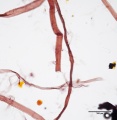Difference between revisions of "Rag"
Jump to navigation
Jump to search
JMcGlinchey (talk | contribs) |
|||
| Line 7: | Line 7: | ||
rag pulp | rag pulp | ||
| − | + | ==Additional Images== | |
| − | + | <gallery> | |
| − | + | Cotton rag 40x endslabel.jpg|Cotton rag paper pulp stained with Graff "C" stain | |
| − | + | Hemp 40x2.jpg|Hemp paper pulp stained with Graff "C" stain | |
| + | Kodakpulp bast40x.jpg|Bast paper pulp stained with Graff "C" stain | ||
| + | </gallery> | ||
== Additional Information == | == Additional Information == | ||
* D. Hunter, Papermaking – The history and technique of an ancient craft, Dover Publications, New York (1978) | * D. Hunter, Papermaking – The history and technique of an ancient craft, Dover Publications, New York (1978) | ||
| + | [[Category:Materials database]] | ||
Revision as of 09:56, 17 July 2015
Description
A scrap or small piece of cloth. In Western papermaking, rag refers to cloth scraps used for paper pulp. Historically, the preferred rags for papermaking were Linen and Cotton, but other textile scraps such as Wool and rope made from Jute or Hemp were also used. Recycled cloth scraps obtained from clothing and household furnishings are called old rag. New rag refers to excess cuttings from the textile industry. Rag produces long Cellulose fibers that make a strong durable Paper. High proportions of rag were used for artists' papers as well as ledger, blueprint, map, and currency papers. Currently many rag papers actually contain Cotton linters instead of rag.
Synonyms and Related Terms
rag pulp
Additional Images
Additional Information
- D. Hunter, Papermaking – The history and technique of an ancient craft, Dover Publications, New York (1978)


